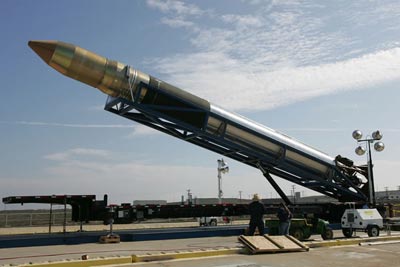The first launch crisisby Charles Pooley
|
| Startups have tended to arrange their plans so as to create “the first launch crisis”: the tendency to plan the effort in such a way as to lead to a climax in the form of a first all-up test of the launch vehicle. |
Although in a SPACE.com article in August he said he is prepared to survive several failures, the outcome of this approach is to develop in the launcher system inbred characteristics that will keep the costs high and the launch rate low. This will lead to a system that is similar to present commercial launchers, with a launch services price only marginally lower. The lower launch rate will not afford the benefits of a learning curve that would result from frequent launches. With the number of people directly involved remaining small and exclusive, there will be no revolution like that which occurred as a result of the advent of small computers.
At the beginning of aviation there was a close competition between Langley and the Wright Brothers to achieve the first heavier than air flight. Langley’s approach was that of several elaborate attempts at launching from a houseboat in the Potomac. The Wrights, by comparison, almost sneaked into the air. Their approach was gradual and incremental, starting with kites, a wind tunnel, and then manned gliders before the culmination of their methodical work in December 1903. They were aeronautical engineers studying systematically how flight might be accomplished rather than entrepreneurs focusing on a quick result.
The development of the novel, high-level technology required for a successful low-cost space access system should also entail a methodical approach aimed first at success then, later, as a generator of a revenue stream. The first launch should be a minor milestone in a steady progression of development and tests. This incremental strategy will lead to a pattern of low cost, high frequency launches.
Coincidentally, the recent adoption by the FAA of a development permit system, which provides for an indefinite number of tests of a given design of reusable launcher, will help with the incremental development approach.
| Recall that the first microcomputers had as little as four kilobytes of memory; people were asking what these simple things could do. They could and did evolve to the PC of today. |
This approach, which I call Microlaunchers, is to start with a vehicle weighing perhaps 500 kilograms at liftoff and designed to send an approximately half-kilogram payload to escape velocity. This pathway leads toward a clean break from the present low-rate, high-cost launch paradigm. A frequent launch rate will encourage the creation of a community of space mission planners and set up conditions for revolutionary growth and a new industry analogous to that which sprang from the microcomputer. Recall that the first microcomputers had as little as four kilobytes of memory; people were asking what these simple things could do. They could and did evolve to the PC of today.
Later, microlaunchers will not need to stay small. Avoiding “the first launch crisis”, experience with the first small system will make raising capital for increases in launcher size relatively easy. The credibility arising from a working, integrated spacecraft system will make development of applications much simpler that with the present expensive high risk, low launch rate systems.
